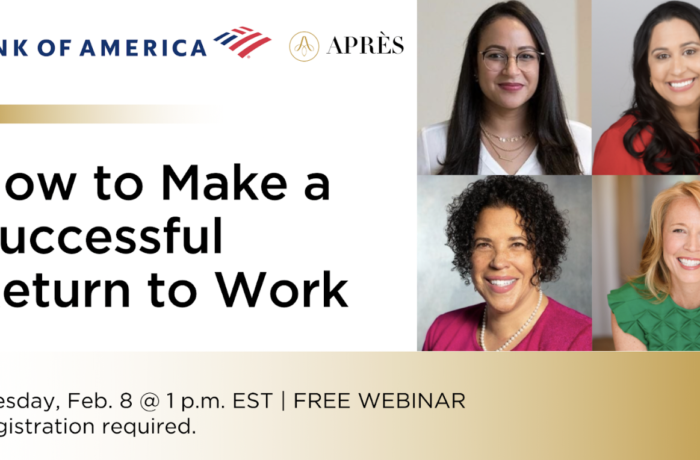Considering going back to work after a break? The process can seem daunting but I encourage you to also look at it as hopeful. This is a new phase in your life and opportunity, and it’s your job to show the world all the great things you have to offer. This is exciting!
Programs like the GSVLabs Reboot Accelerator for Women can be helpful to get you started and refreshed, and this is a list of tips and resources and advice to tackle questions that may be on your mind as you begin your career hunt.
How to address time off, particularly in the interview process.
Be honest and confident. Taking a break can be good for you career.
On your resume, summarize what you have been doing under one heading. Career Coach Jennifer Bevan suggests titling it “Volunteer and Project Work” heading or “Independent Consultant” and creating bullet points for each experience.
Think about the work you are going after and highlight how that’s evident in any volunteer or project-based work you’ve done during the break. Use metrics. Be clear about why you took the break and why you’re ready to go back.
“Own it,” says Linda Wells of Talent Reconnect. IBM’s Erika Adkins says it’s important to be confident in who you are and what you bring to the table. As a hiring manager, she’s interested in the story you have to tell.
How to identify companies that hire folks who have taken a break.
There’s likely no exact science here, but a good place to start is with returnships — essentially “internships” for people over 40. Think of how much experience a company can get with a hire like this? Some large institutions offer programs like this, including Goldman Sachs, JP Morgan and McKinsey, and some tech companies are doing the same. Moz in Seattle is a good example, and Talent Reconnect is offering returnships too.
But these programs often aren’t large and there still aren’t a lot of companies that offer them in a structured manner. You might consider identifying a company that you want to work for and pitching the concept. Does the company you are interested in have full time jobs describing something you would like to do but worry you may not be qualified for? Pitch them on a modified version that allows you to get some experience. A job hunt of any kind requires creativity and some ability to convince a hiring manager why you’re a great hire.
Along these lines, you also might consider careers in an entirely new direction where there could even be training involved. Perhaps you’re interested in learning to code. Perhaps you’re interested in becoming a financial advisor.
Some job posts on Maybrooks highlight they don’t mind if there’s a gap in a resume, so be sure to search our job board. And here’s some advice on when to ask if you plan to ask for flexibility.
Considering tradeoffs between full-time and part-time jobs.
Sometimes necessity will make this an easy decision. Other times family obligations will dictate what makes the most sense. It’s really up to the individual. Either way, make sure your family is prepped and ready for this transition. If you’re conflicted over what you want to do, spend some time envisioning exactly what kind of job you want. How do you want your day to look?
If you do go the part time route, learn to set boundaries so you aren’t working on the days you aren’t working. You can always parlay part time into full time. Companies like Manera Solutions are actively hiring part time employees for client work.
Fighting the age bias: Where does it exist, how to minimize negative impact.
Like other conscious or unconscious bias, you could run into ageism — the AARP says two-thirds of adults between the ages of 40 and 74 have experienced age discrimination. The journalist Stephen Levy has been writing about this particular issue in Silicon Valley on Medium, and is encouraging companies to report the average age of employees in regular diversity reports. This would be illuminating given that the average age at most tech companies hovers around 30.
Seek out companies with inclusive culture — companies that talk about their culture externally or on Maybrooks, and then make sure they talk about it internally, too.
Tips for negotiating your salary.
1. Do your research.
- Check Payscale and Glassdoor for competitive salary information.
- Talk to your network. Ask them to help you understand your value.
- Check out The WAGE Project where you can calculate what your job is worth.
2. Read the negotiation chapter of Sheryl Sandberg’s LeanIn. It’s brilliant. I also recommend Mika Brezenski’s Knowing Your Value.
3. If you’re planning to do consulting work, Kat Eden of Manera Solutions suggests approaching it not by what your time is worth but by what the end product is worth to client.
Resources to start your own business.
Resources to start your own business abound. AMEX Open Forum, The Founding Moms and the Small Business Administration all have tips. Here’s a great guide if you’re looking to freelance.
Working in a multi-generational workforce.
Be curious and willing to learn. Be sure to stay on top of tech trends — we list some communications and collaboration technologies to be aware of in our back to work tool kit, and there are lots and lots of online courses and programs that can help you refresh your skills.
Still need some inspiration? Check out our returning to work resources section with advice from career coaches and experts, and get inspired by moms who have rebooted!
Good luck!





